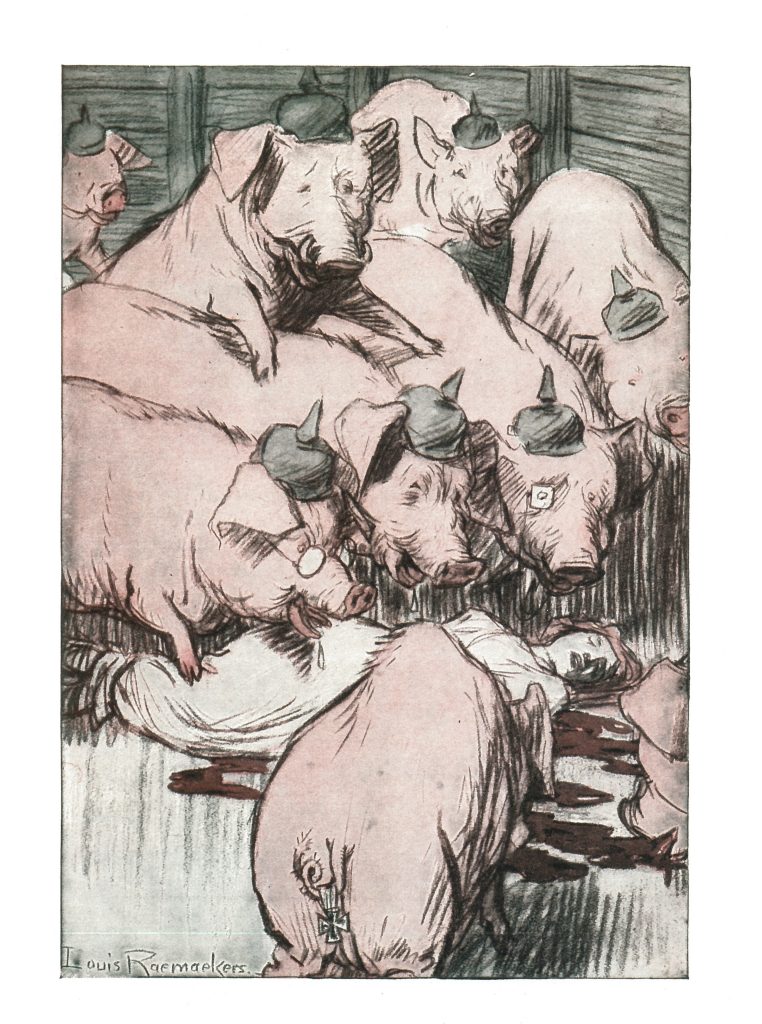By a long shot, the most popular figure in Fitzmaurice’s wartime cartoons was the German head of state Kaiser Wilhelm II. Between July 1916, when the cartoonist returned to the west coast after a six year absence, and the armistice in November 1918, Fitz produced 74 front page propaganda cartoons that featured the Kaiser as the central character. Wilhelm II was a perfect visual propaganda device because his memorable personal appearance – the characteristic handlebar mustache and spiked Prussian helmet, the ‘pickelhaube’ – was so easy to caricature (Figure 1). The Kaiser is considered a “representative individual” by scholars who examine the workings of political cartoons; that is, a real historical personality who is used to represent a group, a people, or a nation. These representative individuals are seen in contrast to “allegorical figures,” personified symbols that represent collectives, nations, principles, or concepts. In his German cartoons Fitzmaurice often mixed these representative figures. One could easily find the Kaiser bickering with “Germania,” a female allegorical symbol representing the will of the German people, while the British allegorical figure, John Bull, looks on.
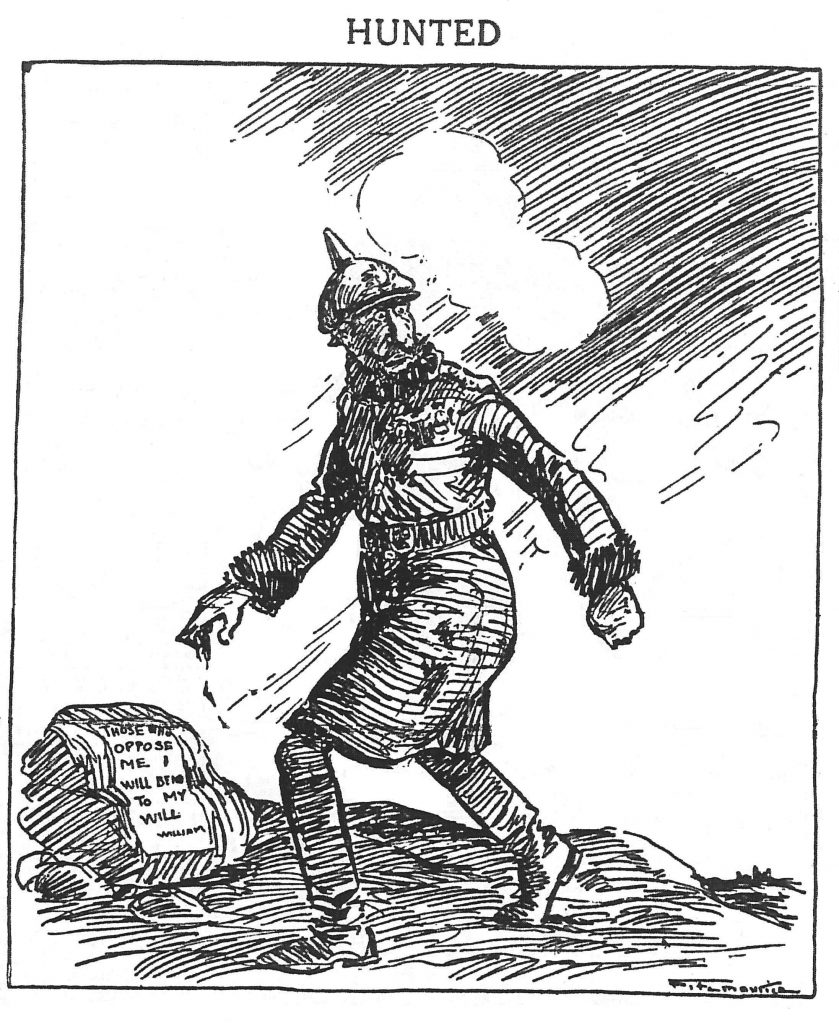
Regardless of the range of personalities, real or otherwise, which crowded the frames of Fitzmaurice’s wartime cartoons, Kaiser Wilhelm II was the star of the show. A steady diet of these images might lead to the understandable assumption that Wilhelm ruled Germany with an iron fist during the war, singularly determining policy, defining objectives, and generally acting as the autocratic – the “All Highest” as critics often nicknamed him. Historians, however, would disagree. When the twenty-nine year old Wilhelm came to power in 1888, and especially after he dismissed then-Chancellor and architect of German unification Otto von Bismarck in 1890, the young Kaiser did attempt to centralize authority in the monarch, a neo-absolutist maneuver scholars refer to as Wilhelm’s “personal rule.” The degree to which Wilhelm’’s personal rule was successful is a matter of great debate among historians; however, most agree that the Kaiser’s greatest direct influence came in the 1890s and began to wane after the turn-of-the-century when a series of traumatic personal crises and scandals led to decline in his authority. Some even suggest the Kaiser was never able to exert the power he was attributed in the press at the time; that a modernizing, complex industrial society like Germany had many sources of often overlapping and competing authorities. That said, there is a consensus amongst historians that the outbreak of war in 1914 led to an even further decline in the Kaiser’s influence. The war gave rise to powerful technical demands of wartime mobilization and military expertise, areas well outside the Kaiser’s narrow skill set, and Wilhelm was reduced to what historian John Rohl calls a “shadow emperor.”
Given his relative insignificance during the war, what then do we make of the central role of the Kaiser in the propaganda images of Fitzmaurice and so many other Allied cartoonists during the Great War? One answer is the average newspaper cartoonists’ ignorance of the detailed realities of German government and state authority. Quite understandable really. Cartoonists were, ironically, the victims of wartime propaganda themselves; they based much of the content and rhetorical meanings of their images on the news services and information sources used by their newspapers, and most of these were coloured by a narrow set of understandings about the enemy – one of which was the active and formative authority of the German Kaiser.
Another reason for the central comic casting of the Kaiser was his bombastic reputation built up over two decades of antics on the world stage. Kaiser Wilhelm was a curious and rather flawed man who combined a strong desire for German power and personal greatness with an embarrassing need for outward flamboyancy, martial display, and an apparent lack of intellectual organization or coherent decision-making. Biographers have been uniformly unkind. In John Röhl’s view, Wilhelm was the author of his own problems – and sadly Germany’s as well – a vain and unpredictable man who ultimately brought disaster to his country and his people. In a recent look at the treatment the Kaiser received in the British press over the course of his life, Lothar Reinermann writes, “his external appearance proved irresistible to caricaturists, who delighted in reproducing his strutting poses, waxed moustache and theatrical uniforms, pouring scorn on his character deficiencies and overweening ambition.” Reinermann maps the development of a public persona, a media caricature built in part by British reaction to events, inherent beliefs about Germany and its intentions, and Wilhelm’s own attempts at “image management.” Far from being consistently negative before the outbreak of war in 1914, British press images of the Kaiser deteriorated sharply once the war began. “After 1914,” Reinermann writes, “cartoons descended to the basest and blood-thirstiest character assassination, reminiscent of modern-day horror comics, depicting Wilhelm variously as butcher, grim reaper or the personification of death, depicted in front of burning houses, violated women, maimed children and murdered prisoners of war.”
In fact, the Kaiser was the central villain in countless newspaper and magazine cartoons across the Allied world during the war. In Britain, a handful of brilliant caricaturists led the way, including F.H. Townsend, Bernard Partridge, and Frank Reynolds at the monthly satirical magazine Punch, Jack Walker at the Daily Graphic, and the established illustrator and freelance contributor Edmund Sullivan. Townsend, Art Editor at Punch, was a particularly gifted artist whose work often graced the front cover of the acclaimed monthly. Figure 2, from Townsend’s December 1914 cover of Punch Almanack, sees the Kaiser as a dragon being slain by St George-like “Mr Punch” on his hobby horse.
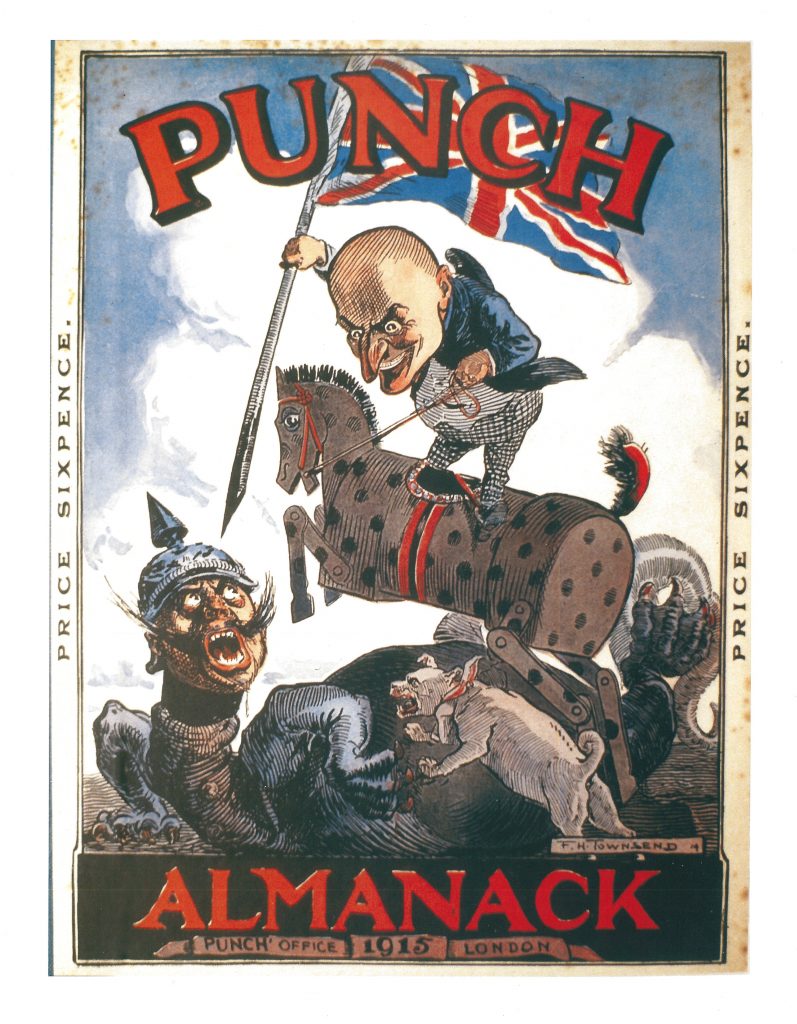
For his part, Edmund Sullivan would produce one of the most important visual propaganda pieces during the Great War, The Kaiser’s Garland (1915), a book of cartoons that featured Kaiser Wilhelm as immoral, brutal, and inhuman. One of the most distributed of Sullivan’s cartoons was “The Ungartered Blackleg” (Figure 3), which sees the British monarch in Shakespearean fashion ripping the garter off Wilhelm to reveal his hairy satanic truth. A critic at the time described The Kaiser’s Garland as a “whole-hearted hymn of hate.”
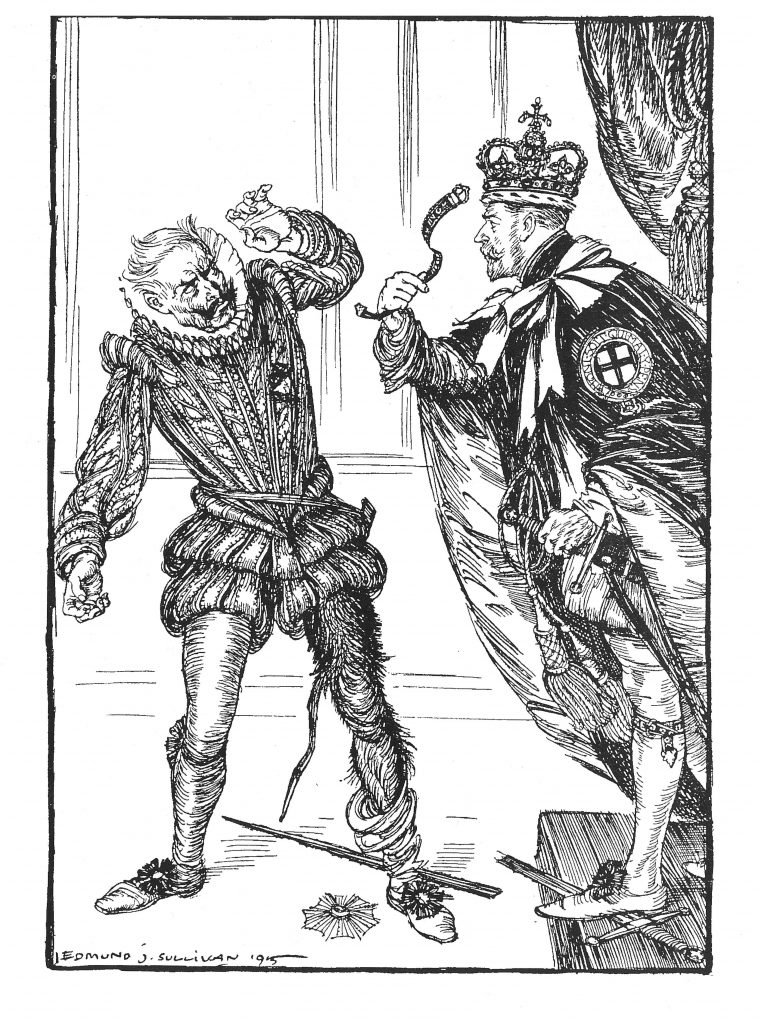
We can add to this list of established British artists several young enlisted soldier-artists who would emerge as important graphic voices during the war itself, such as Bert Thomas, who produced the famous “’Arf a Mo’ Kaiser” cartoon in November 1914. As well, second lieutenant E.H. Shepard contributed occasional cartoons to Punch and other publications while in France, but would go on to great fame with illustrations for the Winnie the Pooh books. Perhaps the best-loved artist during the war was Bruce Bairnsfather, whose memorable cartoon images of the veteran Tommy “Old Bill” reflected the consciousness of ordinary front line soldiers.
Notwithstanding the often-dark characterizations by British cartoonists, nothing could compare with the vociferously anti-German wartime images of Dutch cartoonist Louis Raemaekers. Raemaekers was deeply shaken by the German invasion of neighbouring Belgium and stories of German atrocities on civilians; he produced hundreds of graphic and frankly racist cartoons condemning Germans as brutal barbarians and the Kaiser as an ally of Satan. This was hate propaganda at its worst, and because the publication of the images threatened Dutch neutrality, Raemaekers moved to England in 1916 where his cartoons and their propaganda potential were met with enthusiastic acclaim.
THE DOMESTICATED KAISER WILHELM II
Fitzmaurice’s Kaiser Wilhelm was a far friendlier fellow than the monster portrayed in Raemaekers’ humourless images. Fitz always stressed light hearted humour and the familiar in his cartoons, even when his intended messages were critical and serious. In some instances this undermined the power of his cartoons – his images were never intended to shock readers into action as were the more documentarian testimonies of cartoonists like Raemaekers. One possible reason for this lighter approach was the strategies of ‘visual rhetoric’ Fitzmaurice chose to use in much of his work. The most important of these tools was ‘domestication,’ which refers to placing the caricatures of serious public figures in common domestic settings and situations. Typical of Fitzmaurice’s approach is the cartoon “Hates to Pay the Price,” (Figure 5), a front-page cartoon from late January 1917. In this image we find Kaiser Wilhelm as a father struggling with the cost of ending the war outside the “Allies Peace Shop.” As his son, the “German People,” cries out for the gift of peace, the reader notes that the boy had been given an earlier toy, a stick and ball, which spells out “promises of victory.” Note as well that the price of peace at the Allies Peace Shop is “unconditional surrender.” In keeping with the elements of domestication, the characters are placed in a common, everyday setting that would have been widely understood, especially by a middle-class Vancouver audience: father and son debating a toy purchase outside a retail store window.
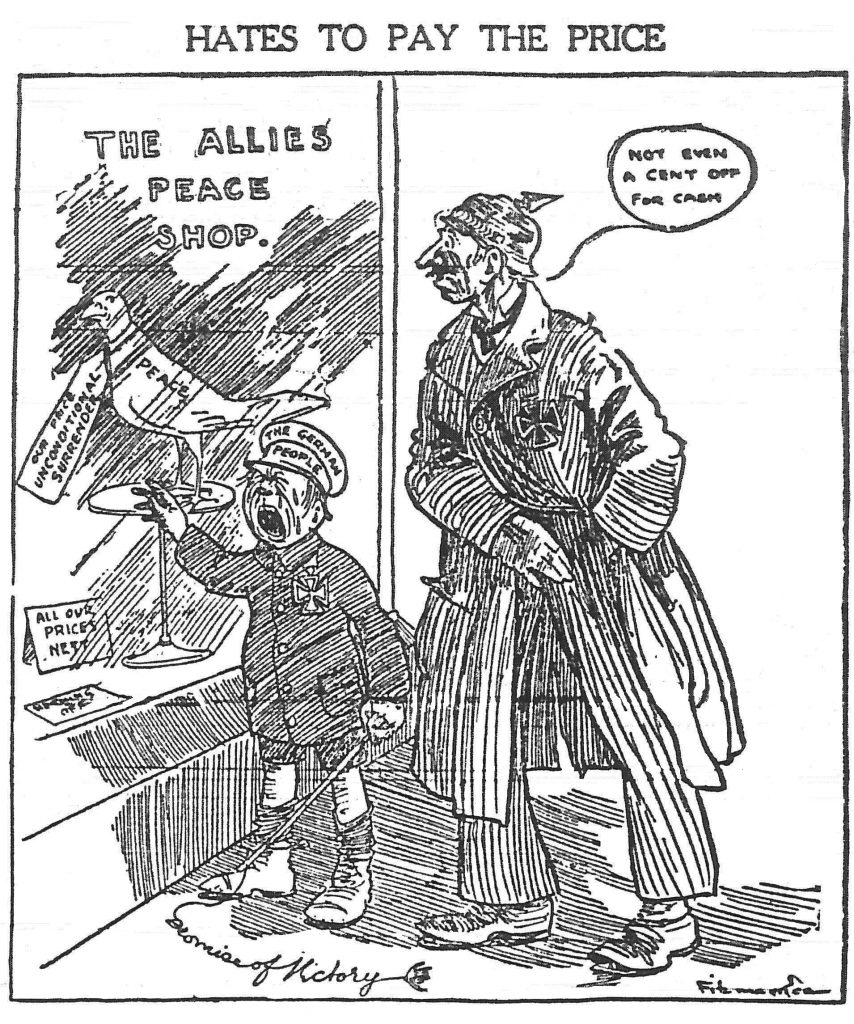
Figure 5: Hates to Pay the Price (Province, 29 January 1917)
The juxtaposition of placing major historical figures in banal settings formed the basis for humour in these propaganda cartoons. It also made what often were complicated international issues more accessible to readers. That said, Fitzmaurice packs a lot of meaning into “Hates to Pay the Price.” For instance, the German People want peace, while the Kaiser is hesitant to pay the price. Fitz rarely blamed the war on the German people; most of his cartoons suggested a wide gulf between what he saw as the fundamentally moral German people and their immoral, illegitimate leadership. Other cartoonists – British and American – were not nearly as forgiving of the German people. Nonetheless, support for the goal of unconditional German surrender is crystal clear from this cartoon. By the end of 1916 the war was “to-the-death” for Fitz and most other commentators. To do less so, they would have argued, would dishonour those who had already lost their lives in France.
The figure of the Kaiser in Fitzmaurice cartoons often stood for much more than the flesh and blood man known as Wilhelm Hohenzollern. Fitz’s Kaiser was sometimes drawn as an allegory for the German regime and the objectionable values that had pushed the world into war. Taken altogether, the symbolic figures within the cartoon frames are not consistent. In some images Fitz would present the Kaiser as the embodiment of German military strategy; in others he is shown in conflict with German generals who formulated that strategy. In over a dozen cartoons Fitz drew the Kaiser as a human symbol for the well-worn list of German war aims that formed the core propaganda message in Allied countries, namely the defense of autocracy, militarism, and world domination; in other cartoons the Kaiser played the part of a weak, confused, and ineffective Wilhelm II. Whether allegory or man, Fitz’s Kaiser was never presented as an embodiment for all Germans. That said, Fitz’s Kaiser was always the reason for why the Allies were at war.
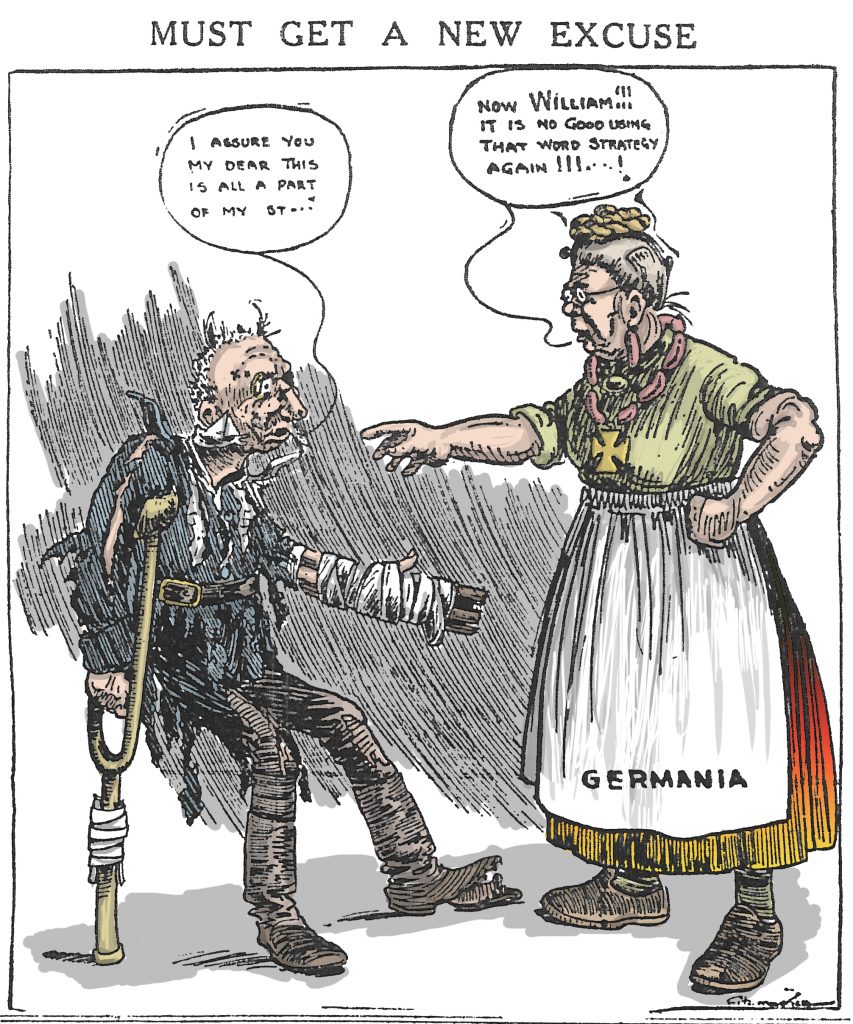
Another example of Fitzmaurice’s use of domestication in his visual construction is the cartoon “Must Get a New Excuse” (Figure 5) from April 1917. In this image Fitz plays with the tension arising from marital conflict. A badly roughed up husband Wilhelm returns home after a rollicking night out and offers an excuse for his condition to his frustrated spouse “Germania,” who sports some of the then-stereotypical features of German ethnicity including a sausage necklace…. The negative re-framing of German military strategies for propaganda purposes occupied Fitzmaurice’s pen often. This was particularly useful when Allied fortunes took a turn for the worse, or when British and/or Canadian casualty rates spiked. The common domestic relationship used here suggested certain beliefs about Germany and its leadership. For instance, like a troubled marriage, Fitz suggests the German wartime elite was in conflict with the German people, that deception, lies, and abruptly differing goals separated the Kaiser and his generals from the best interests of Germany.
How accurate this was is today a matter of historical debate. Certainly the war began with a great sense of unity based on the cultivated perception that Germany was a victim of British, French and Russian designs, the so-called “Spirit of 1914.” However, as was true of belligerents on all sides, that unity began to fray with the realization of a long war, climbing and appalling casualty rates, and by 1916 for Germany, the strangling effects of the British blockade felt by both the civilian population and some sectors of the German army. Historical accuracy, however, was never a significant concern in Fitzmaurice’s propaganda cartoons – these front page images were meant to raise morale, not provide accurate war news for readers.
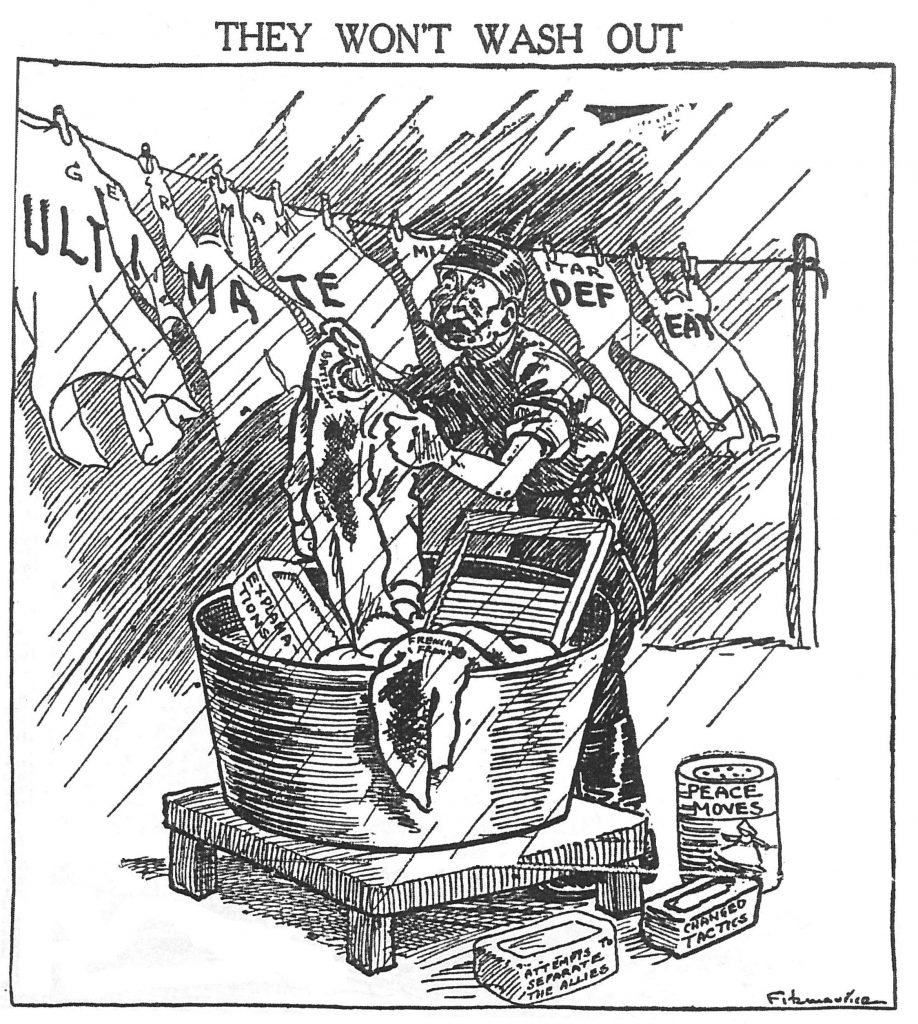
Another favourite domestic setting for Fitzmaurice was to frame male public figures in the process of doing their laundry. Fitz reserved his ‘wash day’ cartoons for antagonists and their attempts to ‘wash away’ their improprieties, lies, or morally reprehensible acts. The October 1917 cartoon, “They Won’t Wash Out” (Figure 7), sets out the standard form for these images. The Kaiser is seen trying to clean away the stains of “German Military Ultimate Defeat” with the use of “Explanations,” “Attempts to Separate the Allies,” “Changed Tactics,” and “Peace Moves,” all without success. The recent revolutionary upheavals in Russia which precipitated the Bolsheviks to sue for a separate peace treaty in November 1917 helps to explain the timing of this cartoon, as does the German attempts at peace negotiations throughout the first half of 1917. As Roger Chickering argues, however, a negotiated end to the war was likely impossible; both sides considered such a compromise an abandonment of the huge sacrifices already made: “A negotiated peace could neither balance the moral account nor vindicate the sacrifice. Compromise required an altogether different representation of the war – as a miscalculation. No government anywhere could have survived this terrible confession.”
Fitzmaurice’s recurring images of washing away sins had great currency in this period of Christian social reform. Industrialization, rapid urbanization, and high levels of immigration created a host of social problems and concerns that were met by a diffuse set of overlapping social reform movements, the most popular of which were the prohibition movement and the drive for women’s suffrage. While Fitzmaurice or his newspaper was never outward supporters of either prohibition or the right of women to vote, social reform references frequently coloured his images. In the cartoon “Hunger Striking” (Figure 8) from January 1917, Fitz places the Kaiser, along with the allegorical Central Powers Austria-Hungary, Bulgaria, and Turkey, behind bars to imitate the protests of radical women’s suffrage advocates on hunger strikes. Not categorically domestication in its visual rhetoric, the image does build its humour from the mash-up of two different public issues. The jailer, “The Allies,” threatens to forcibly feed his prisoners “Reparations,” “Restitution,” “Allied Peace Terms,” and “Humble Pie” if they do not have them willingly. German resolve, represented here by the Kaiser, is firm. That of the less committed Central Powers, not so much….
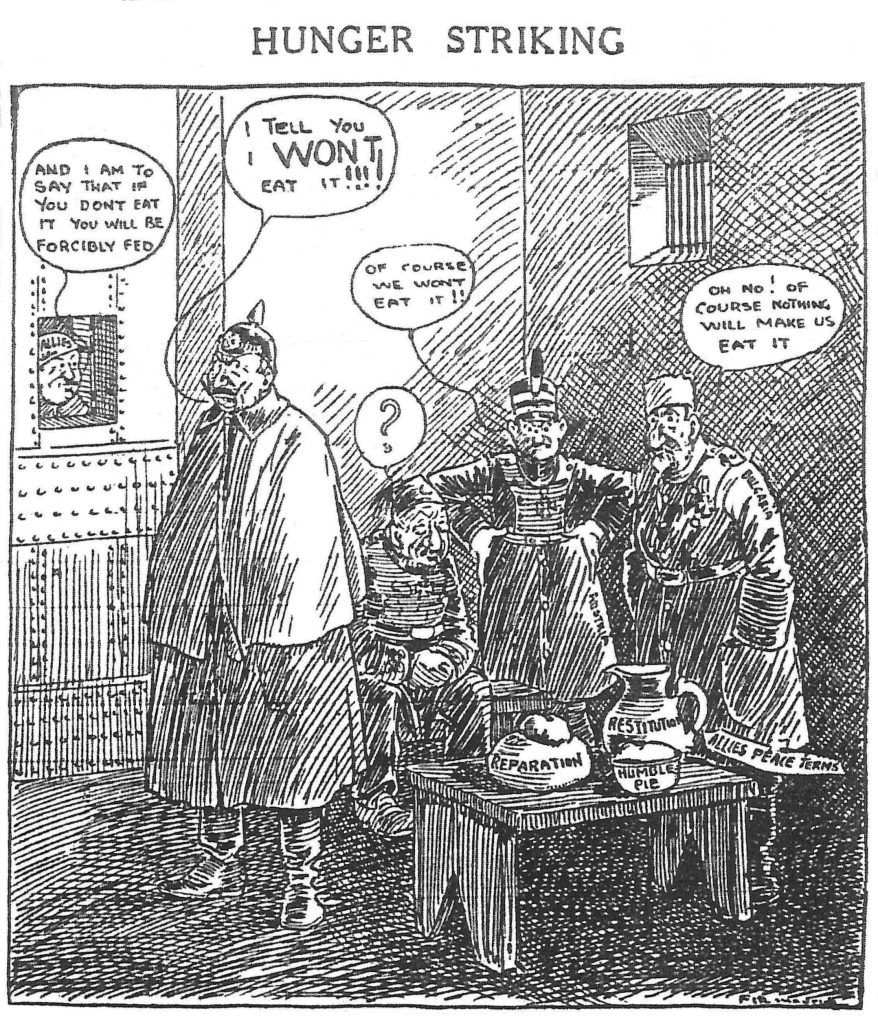
Figure 8: Hunger Striking (Province, ???)
THE KAISER’S WAR AIMS
“Hunger Striking” was one of over a dozen wartime propaganda cartoons that featured the Central Powers, led by a frustrated Kaiser, quarreling over war aims, strategies, and outcomes. One of the best of these is “When Thieves Fall Out” (Figure 9) from October 1916. Here we see allegorical figures to represent the Central Powers again revealing their lack of solidarity, which mostly stems from the Kaiser’s moral shortcomings. Fitzmaurice would often evoke, for comic effect, a recurring cast of characters in an extended series of episodic cartoons over several weeks or months. Fitzmaurice initially developed these series cartoons before the war to comment on Canadian Federal or Provincial elections. Fitz would establish caricatures of rival non-Conservative candidates performing a variety of moronic electioneering stunts much like a vaudevillian troop. The wartime cartoons “Hunger Strikes” and “When Thieves Fall Out” mimic this comic structure, and they do so with two consistent propaganda messages: first, to show that Germany had tricked its allies into going to war with promises it could not keep; and second, that deception and hidden agendas separated each Central Power and undermined any real united sense of purpose. These weaknesses would, it was believed, help lead to their defeat by a supremely united and morally legitimate Allied Entente.
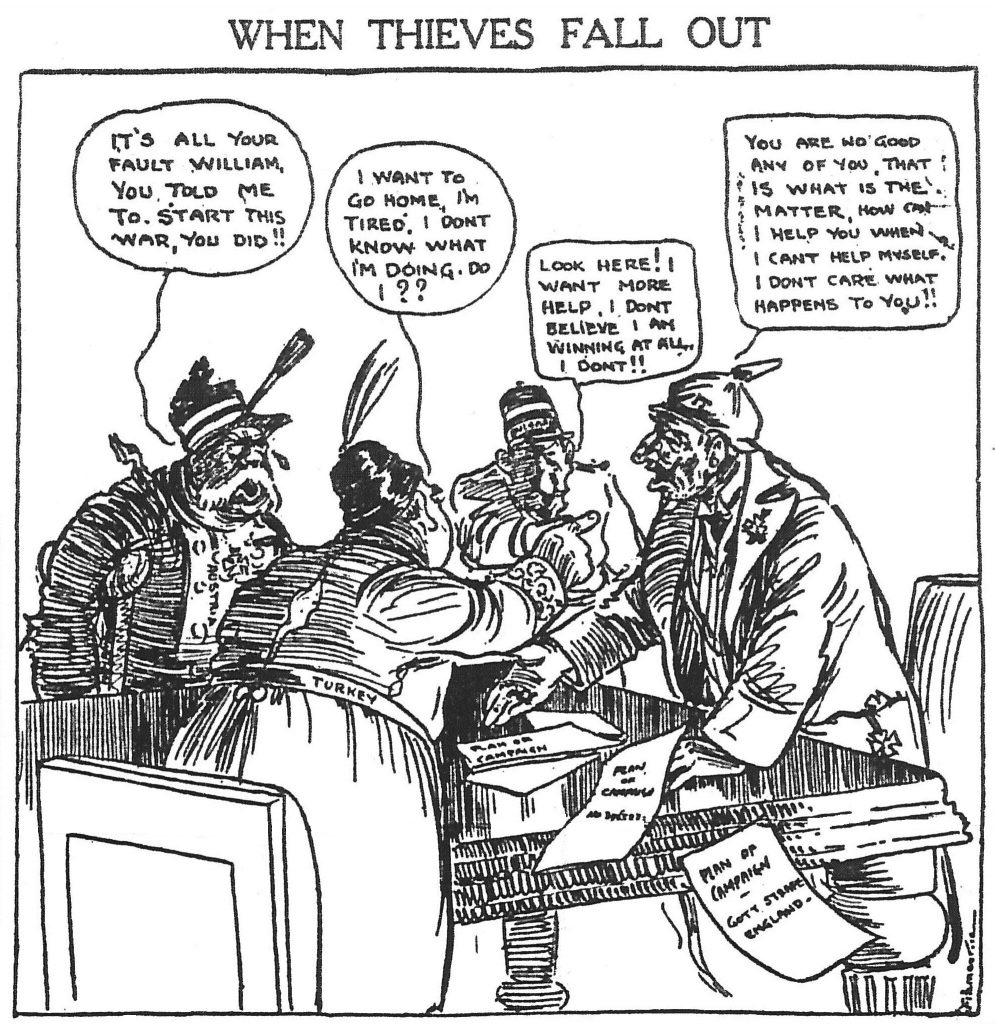
Figure 9: When Thieves Fall Out
The underlying confidence in Allied victory displayed by Fitzmaurice’s cartoons was based on a biased understanding of the war aims of both the Allies and the Central Powers. Historians tell us that the official goals of war for both sides were never very clear and that they changed over time to meet contingencies at home and in the field of battle. Not deterred, many of Fitzmaurice’s Kaiser cartoons reminded British Columbian readers of why they were fighting the war. These images offered up a pool of nefarious German war aims from which to choose: defense of autocracy, the divine right of kings, militarism, transgression of the laws of humanity, and world domination. The cartoon “Clean Up Year” (Figure 10) does just that. A soldier representing “The Allies” sweeps some of these corrupt German war aims off the earth (including what looks to be a bust of the Kaiser) with the goal of a “permanent peace” after the housework is done.
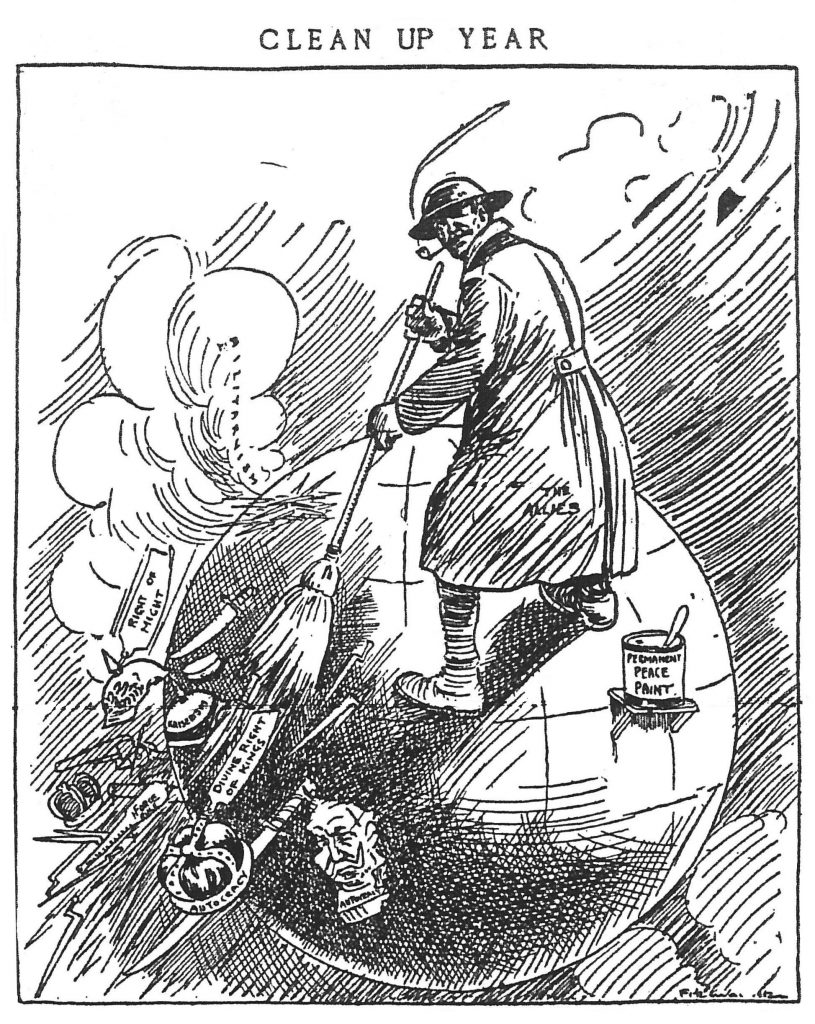
Figure 10: Clean Up Year
In another image that catalogues heinous German war aims, the Kaiser is brought face-to-face with his “debts to civilization” in “The Morning After” (Figure 11) from the fall of 1916. Framing German transgression as a mad evening out, Fitzmaurice accuses the German Kaiser of a list of crimes that ends with “disregard of all the laws of decency and humanity.” This image is also one of Fitzmaurice’s cartoons that reflected the hope that Germany would pay for its actions after the Allied victory was secured, the very issue that would dominate diplomacy in the post-war world and shape the course of the twentieth century.
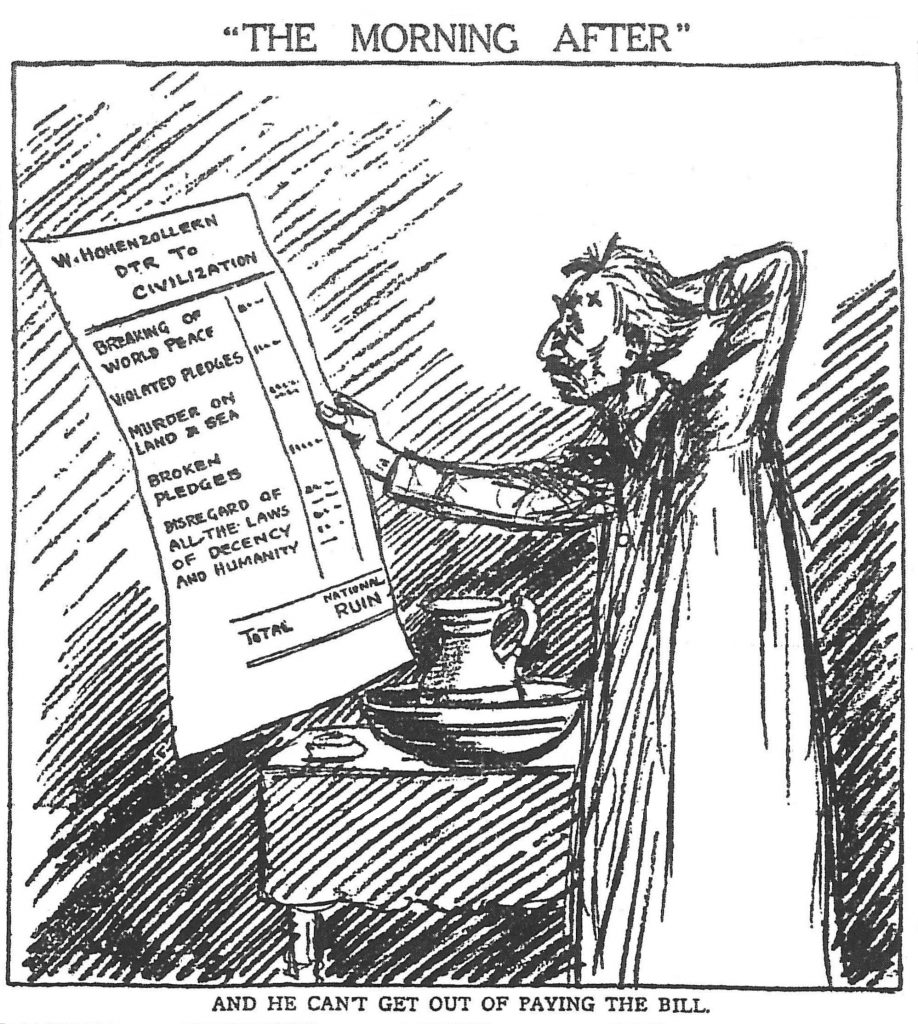
Figure 11: The Morning After
WILHELM GOES DOWN WITH THE SHIP
As the tide of war began to turn in the summer of 1918 and the Allies entered the “Last Hundred Days” that would see real gains on the Western Front, Fitzmaurice’s Kaiser Wilhelm would appear in a series of imminent disaster cartoons. These images presaged the death, not of the real Kaiser, but of the German regime and the values this allegorical Kaiser represented. The sea disaster was a favourite setting for these end-of-war cartoons. “William Will Stay With The Ship” (Figure 12), from October 1918, casts the Kaiser and an allegorical Germany adrift and clinging to ship debris dubbed “Hohenzollern Autocracy;” Germany has decided to accept rescue in the form of “Complete Surrender,” while the Kaiser and the values he represents is left to go down with the ship.
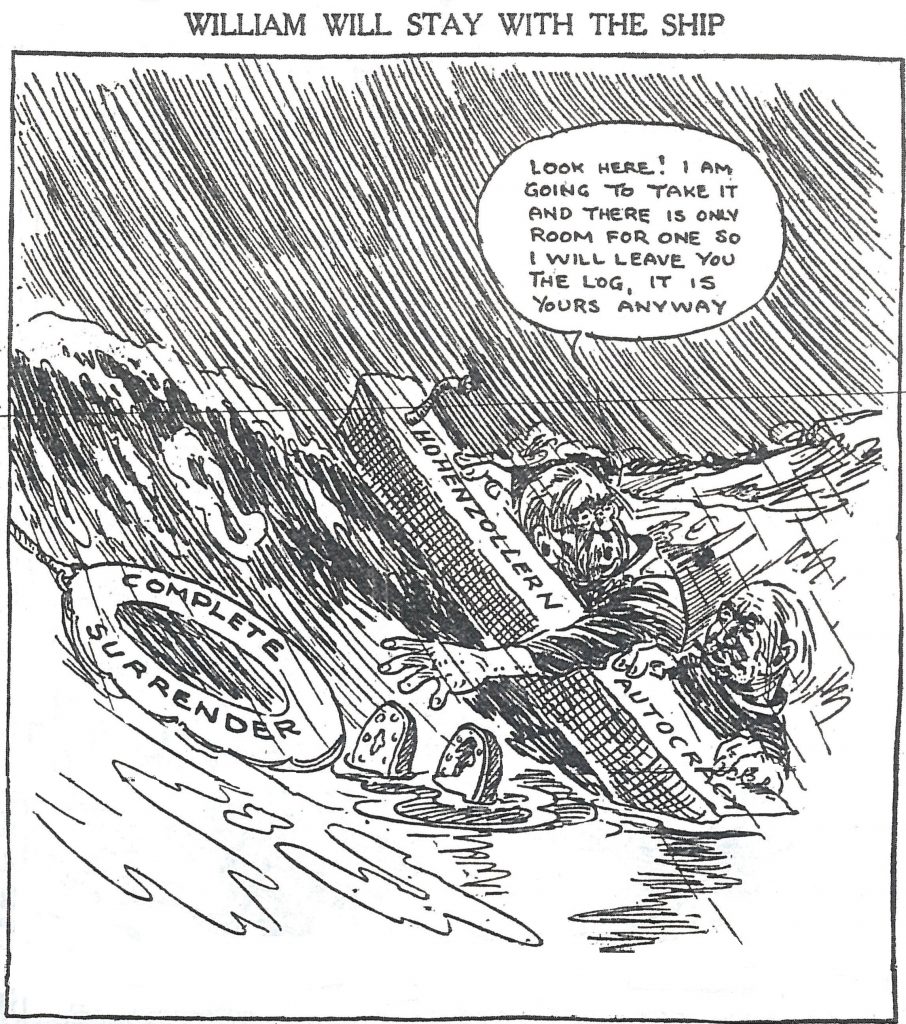
Figure 12: William Will Stay with the Ship
Another end-of-war image is “The Situation is Grave” (Figure 13) from September 1918. Here the Kaiser lies in an open grave marked “Here Lies Hohenzollernism” as the Allies, confident of victory, buries him and his ideals alive. All of these imminent disaster and death cartoons underlined the distinction Fitzmaurice made between the Kaiser and the German people, but also between the real life Kaiser Wilhelm II and the allegorical Kaiser that represented the values the Allies fought against in four long years of war.
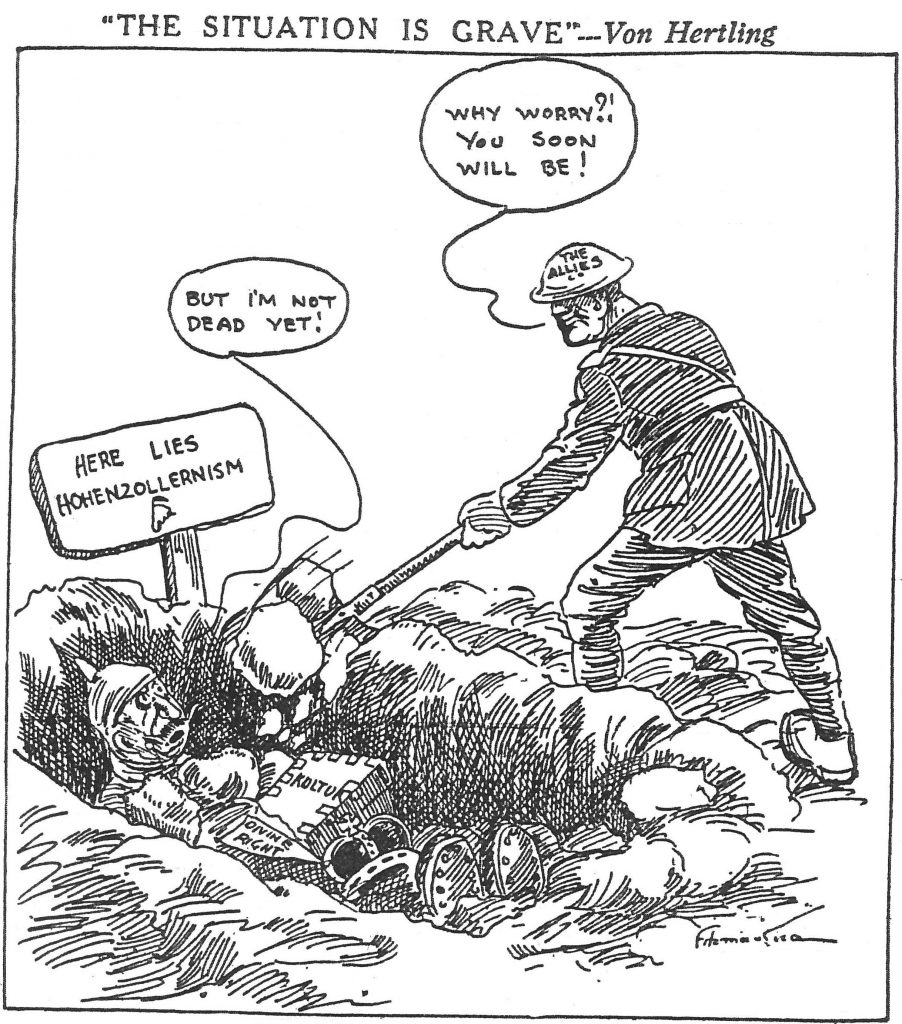
Figure 13: The Situation is Grave
It is significant that the actual abdication of Wilhelm and his exile to neutral Holland to live out his life was never commented on by Fitzmaurice. Fitz’s Kaiser, more allegory than man, died in November 1918.
